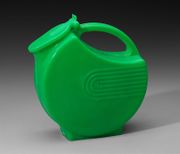Polystyrene
Description
A thermoplastic polyolefin made from styrene with a general composition of [-C6H5CHCH2-]n. Although probably known earlier, polystyrene was described in 1839 by E. Simon of Germany, after he watched the clear Styrene liquid distilled from storax resin cool then harden to form a solid mass. Polystyrene was first commercially made in 1929 by I.G. Farben (Germany) for use in styrene butadiene synthetic rubbers. Polystyrene is a hard, strong solid with good dimensional stability and impact resistance; it can be molded and fabricated. Polystyrene is often prepared as an expanded foam (Styrofoam®) using blowing agents for use in temperature and sound insulation. It can be co-polymerized with many other polymers for increased flexibility, i.e. ABS rubbers are made from Acrylonitrile, Butadiene, and styrene.
Examples include:
| Polystyrene Forms | Uses | Products |
|---|---|---|
| Extruded Foam, Closed Cell | Container, Padding, Packing | Dow Chemical: Styrofoam
|
| Polystyrene core laminated with paper or plastic on both sides | Support, Backing | 3A Composites: Fome-Cor
|
| Expanded polystyrene foam | Loose-fill molded pieces | patented Dow Chemical: Packing peanuts (packing noodles, foam popcorn) |
Synonyms and Related Terms
PS; styrene polymer; polystyrène (Fr.); poliestireno (Esp.); polistirene (It.); poliestireno (Port.); styrene resin
Examples: Styrofoam® [Dow]; Luran; Styron; Lustrex; Fome-Cor®; Algil [Polymers, Inc.]; Permene [Modglin Co.]; Shalon [Polymers, Inc.]; Polyfil [Mack Molding]; Durastran; Plexene
Applications
- Foam, peanuts
- Transparent enclosures, containers
- Inexpensive rigid plastics: disposable cutlery, cabinets, furniture
- Foam boards, insulation
Personal Risks
Aldrich Chemical: MSDS
Collection Risks
- Degrades in UV radiation and light which causes yellowing and embrittlement.[1]
- Photo-oxidation increases “Plasticizers exuding from PVC are very good solvents and can dissolve polystyrene boxes.” [2]
- Polystyrene carries a static charge and attracts dust.
- Poor shock absorber.
Environmental Risks
Physical and Chemical Properties
- Chemically stable at room temperature [1]
- Attacked by hydrocarbon solvents, oils, ketones, esters, inorganic acids.
- Resistant to organic acids, alkalis, alcohols.
- Shrinks in boiling water [2]
- Burns with luminous smoky flame giving faint odor of marigolds.
- CAS = 9003-53-6
- Melting Point = softens about 150C
- Density = 1.060
- Refractive Index = 1.59
Comparisons
General Characteristics of Polymers
Physical Properties for Selected Thermoplastic Resins
Sources Checked for Data in Record
- ↑ 1.0 1.1 Shashoua, Yvonne. Conservation of Plastics: Materials Science, Degradation and Preservation. Amsterdam etc.: Elsevier, 2008. 248
- ↑ 2.0 2.1 Scott R. Williams. Plastic Storage Products. In ‘Preventive Conservation: Collection Storage’ Lisa Elkin and Christopher A. Norris (eds.), Society for the Preservation of Natural History Collections, New York. 2019. 774
- Contributions: Gina Watkinson, AIC Plastics Panel, 2020.
- The American Heritage Dictionary or Encarta, via Microsoft Bookshelf 98, Microsoft Corp., 1998
- R. J. Gettens, G.L. Stout, Painting Materials, A Short Encyclopaedia, Dover Publications, New York, 1966 Comment: ref.index= 1.50-1.75
- G.S.Brady, Materials Handbook, McGraw-Hill Book Co., New York, 1971 Comment: ref. index = 1.59
- Dictionary of Building Preservation, Ward Bucher, ed., John Wiley & Sons, Inc., New York City, 1996
- Theodore J. Reinhart, 'Glossary of Terms', Engineered Plastics, ASM International, 1988
- Lynda A. Zycherman, J.Richard Schrock, A Guide to Museum Pest Control, FAIC and Association of Systematics Collections, Washington DC, 1988
- R.D. Harley, Artists' Pigments c. 1600-1835, Butterworth Scientific, London, 1982
- Pam Hatchfield, Pollutants in the Museum Environment, Archetype Press, London, 2002
- Thomas C. Jester (ed.), Twentieth-Century Building Materials, McGraw-Hill Companies, Washington DC, 1995
- M.Kaufman, The First Century of Plastics, The Plastics and Rubber Institute, London, 1963 Comment: first developed commercially in 1930
- F. Kidd, Brushmaking Materials, Bristish Brush Manufacturers, London, 1957
- Sharon Blank, An introduction to plastics and rubbers in collections, Studies in Conservation, 35, 53-63, 1990 Comment: used in synthetic rubbers since 1927... it was first used as polystyrene in the mid 1930s
- Art and Architecture Thesaurus Online, https://www.getty.edu/research/tools/vocabulary/aat/, J. Paul Getty Trust, Los Angeles, 2000
- History of Plastics www.nswpmith.com.au/historyofplastics.html Comments:In Europe, I.G.Farbenindustrie: experiments 1924, production 1929 In US, Dow Chemical: experiments before 1930, production 1937



